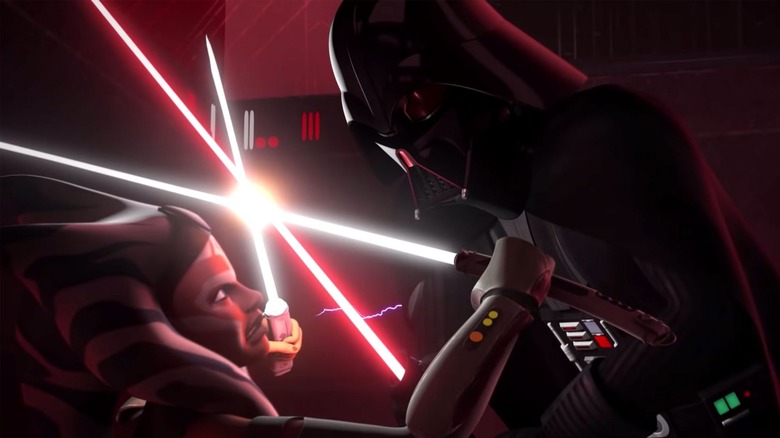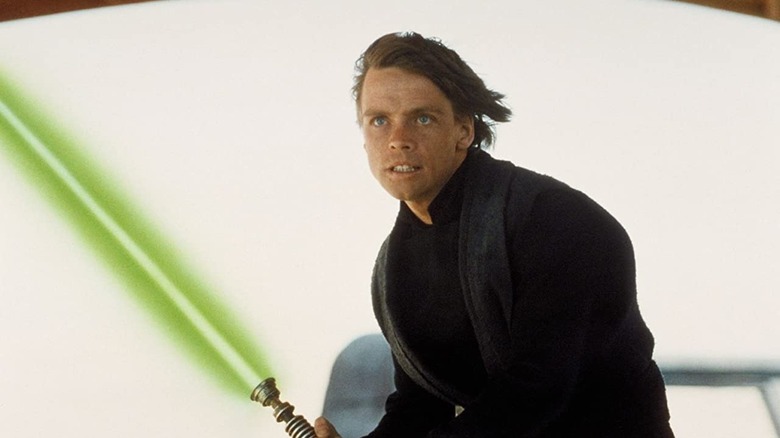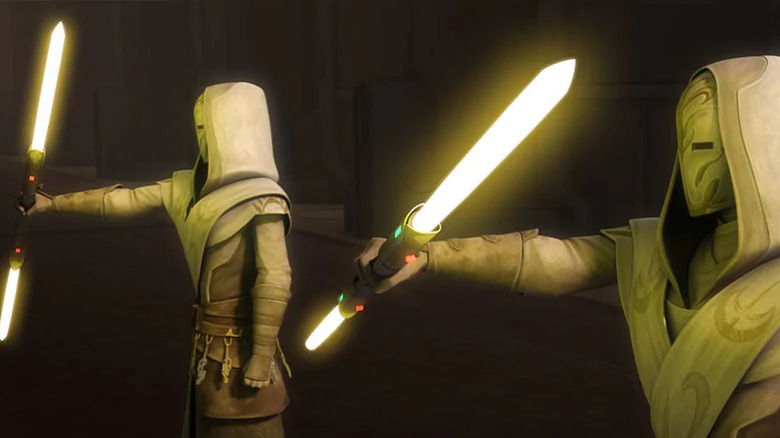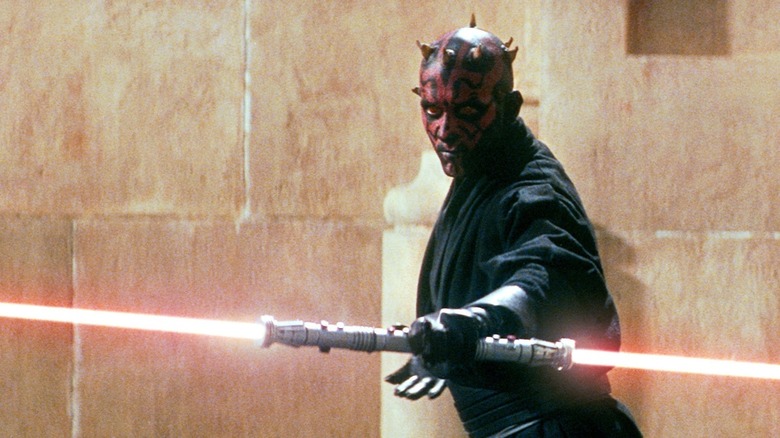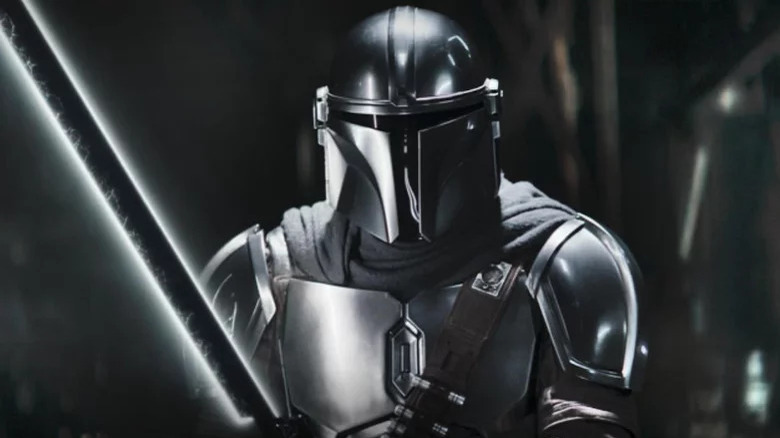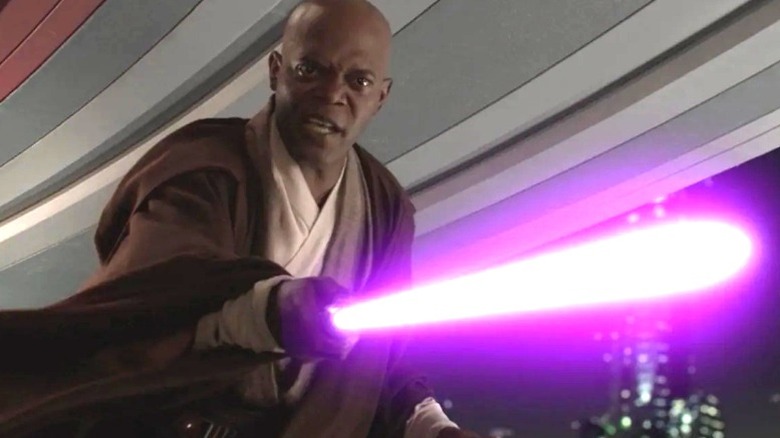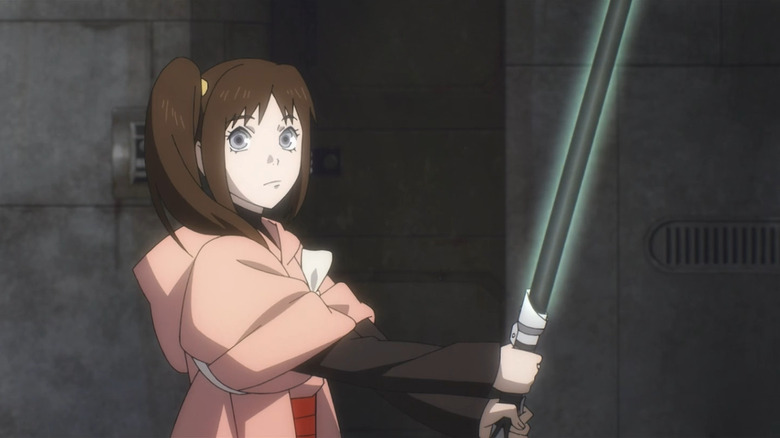Every Star Wars Lightsaber Color Explained
The mythos of the "Star Wars" galaxy is powered by lightsabers, the famous laser swords of George Lucas' galaxy far, far away. The elegant weapon of the Jedi (and a favorite of cosplayers), they make woo-woo-whoosh noises courtesy of sound designer Ben Burtt. They stab, melt metal, cut through limbs and torsos, or deflect blaster bolts. George Lucas conceived them as defensive weapons capable of batting away lasers, befitting the peacekeeping ways of the Jedi, defenders of the galaxy and disciples of the Force.
Yes, they're cool, but their sacred meaning to their users is not to be trifled with. At the heart of the lightsaber is the kyber crystal, a sentient conduit of the Force. When a Force-wielder places it into their lightsaber hilt, the Force-attuned kyber will connect with them. Thus, the lightsaber plasma beam manifests a color that represents the user's allegiance and relationship to the Force, be it turmoil or balance.
From the movies to the cartoons and video games to live-action series, /Film spills the spectrum of lightsaber colors, detailing their meaning and history.
Blue
Blue is the color of the sky and water and is one of the two most ubiquitous colors of the Jedi lightsabers. It is the very first lightsaber beamed onscreen in "A New Hope." Obi-Wan Kenobi introduces it as "Not as clumsy or random as a blaster, an elegant weapon for a more civilized age." The old Jedi's words set in stone their association with control and precision, something that young Luke Skywalker has to master with patience throughout the original trilogy. The color blue creates a striking contrast when Obi-Wan Kenobi's blue blade strikes Darth Vader's red saber.
In the non-canon "Knights of the Old Republic" game, blue denotes a combative Jedi Guardian who applies the Force on a physical level. In "Rebels," Kanan Jarrus and Ezra Bridger are also known canonical wielders of the blue blade. For much of the original trilogy, blue existed as part of the blue-red binary of Jedi vs. Sith — blue blade against red blade. Then, the "Star Wars" galaxy expanded and explored a myriad of lightsaber colors on the light side spectrum.
Green
Next to blue, green is a common color for the Jedi lightsaber. Qui-Gon Jinn and Master Yoda are well-known wielders of the green lightsaber.
The first ever green lightsaber seen onscreen is Luke Skywalker's replacement lightsaber in "Return of the Jedi," constructed after he loses his inherited blue saber. From a technical perspective, green was a practical hue. According to Lucasfilm Story Group creative executive Pablo Hidalgo, Luke's second saber was supposed to be blue but it would have blended with the blue sky. Green was a more striking color against the sky and Tatooine sands. "As much as we like to mythologize why it's green and what that all signifies," Hidalgo said, "sometimes there are very pragmatic filmmaking reasons behind these things." That said, it is not thematically unnatural that Luke Skywalker would end up forging a green blade after losing his blue one since green symbolizes growth and restoration. This symbolism extends to Ezra Bridger's second green lightsaber after he breaks his blue lightsaber.
The non-canon "Knights of the Old Republic" drew distinctions between blue and green. If blue is for the Jedi Guardian who focuses on combat, green is for the meditative Jedi Consular who bears diplomatic responsibilities.
Yellow
In the days of the Old Republic, the double-bladed yellow lightsaber was the weapon of the robed and masked Jedi Temple Guards. These guards would stay behind to defend the Jedi Temple from threats while Jedi Knights and masters ventured on dangerous missions far from home. Their masks are the ultimate expression of emotional detachment.
While yellow may signify detachment for the guards, the color assumes different nuances for individual users. At the end of the sequel trilogy, Rey (now declaring herself a Skywalker) builds a gold lightsaber. It represents her carrying the torch of the Jedi legacy while forging her own path. She has attained balance in the Force. In addition, Ahsoka Tano wielded a gold shoto lightsaber (a lightsaber with a shortened blade) to go with her green lightsaber. The yellow epitomizes her experimentation beyond Jedi norms and testing her potential, foreshadowing her signature use of dual white blades.
White
White is an interesting and rare hue for lightsabers. At one time, Ahsoka Tano owned two blue lightsabers, given to her by her former master, Anakin Skywalker when she allied with (but did not rejoin) the Jedi cause to capture Darth Maul in "The Clone Wars." Master Skywalker wanted to acknowledge that she has grown beyond the Jedi Temple, yet he gave her a color that's typical of Jedi sabers and still represented her allegiance to the light side. Later, white will indicate her non-affiliation with either Jedi or Sith. In the subsequent events of E.K. Johnston's novel, "Ahsoka," she constructs a pair of white lightsabers from the red kyber crystals of an Inquisitor's destroyed sabers. Their color comes from the purification of the reddened crystals.
White and its association with purification pairs perfectly with Ahsoka, a Force-user who has undergone symbolic deaths and rebirths that include leaving the Jedi Temple. At the end of "The Clone Wars," she's cloaked in dusty white which indicates how the war tainted her. But at the end of "Rebels," she bears a pure white cloak after she wanders through the Sith-constructed Malachor. White is Ahsoka Tano's iconic color.
Red
Red represents a river of rage and blood. As detailed in the "Star Wars" novel "Ahsoka" by E.K. Johnston, devotees of the dark side do not have a peaceful Force connection to the kyber crystal like the Jedi. They have to force the crystals to work for them. This "bleeds" the crystal, causing it to turn blood red.
Famous red blade wielders include Darth Sidious, Darth Maul, Darth Vader, the Inquisitors, and the Knights of Ren. Disciples of the dark side tend to get creative with their designs (sorry, you boring light siders). The first double-blade lightsaber seen onscreen is Maul's crimson double-bladed saber in "Star Wars: The Phantom Menace." The Inquisitors, however, use their two-bladed sabers for more than just combat. They use their spinning double blades as one-person helicopters for flight. "Star Wars: Visions" also depicts red kybers fashioned into a parasol-like saber.
So intense and unstable is Kylo Ren's flawed kyber crystal that he crafted side vents, creating his lightsaber's notorious crossguard as a safety measure to keep the crystal from overloading the hilt. Not that it stops Kylo Ren's lightsaber from being the memetic butt of jokes, even to "Star Wars" fans who find it cool. After all, it suits his infantile temperament.
Black
Unlike red, black is far from negative when it comes to lightsabers. The flat-bladed, one-of-a-kind Darksaber bears a complex and storied history. If the rare purple and white lightsabers are made famous by their individual users, the Darksaber is fascinating because of its multiple Mandalorian and Jedi masters.
"Clone Wars" supervising director Dave Filoni brainstormed the idea of a unique Mandalorian-made lightsaber with a black blade. A millennium before the events of "Star Wars," its creator, Tarre Vizsla, is documented as the first Mandalorian inducted into the Jedi Order. The hilt of dark beskar proudly symbolizes the Mandalorian hands that built it just as the kyber represents Tarre's loyalties to the Jedi Order. Mandalorian legends tell that it was a symbol of unity in Tarre Vizsla's grip. However, its purpose of reconciling two seemingly paradoxical cultural heritages was corrupted. When Tarre died, the Jedi took possession of the Darksaber, but it was stolen (or in the words of the Mandalorians, "liberated") in a raid by House Vizsla. In the hands of Tarre's descendant, Pre Vizsla, the Darksaber is a Jedi killer. In the hands of the notorious Maul, it was used to assassinate the pacifist Mandalorian ruler, Satine Kryze.
The Darksaber remains a symbol of Mandalorian leadership. Custom dictates that it can be won in a fair duel from its current wielder. As of now, Mandalorian Din Djarin holds it. A relic and a functional blade, its ownership is constantly in dispute and its purpose in flux.
Purple
If blue and green are the typical hues of Jedi lightsabers, why does Jedi Master Mace Windu get a purple one? The behind-the-scenes answer is that actor Samuel L. Jackson asked George Lucas, "You think maybe I can get a purple lightsaber?" The purple saber allowed Jackson to pick himself out in a crowd of green and blue Jedi lightsabers in the First Battle of Geonosis in "Attack of the Clones."
Mace's unique purple blade gave "Star Wars" fans the license to go crazy with theories. Red and blue make purple, so it's evident that Mace Windu's blade contains a balance of the light and dark sides of the Force. In the non-canon comic "Star Wars Tales" #13, the native Hurikane species gave Mace Windu a violet-colored Hurrikaine crystal to construct the lightsaber of his Force vision. The color Purple is a testament to Windu's standing as a Jedi who veers dangerously close to the dark side without succumbing to it. In Claudia Gray's canonical novel "Master and Apprentice," Obi-Wan Kenobi explains that sometimes, "a few crystals even turn purple" when a Jedi bonds with the kyber. So purple is a rare phenomenon but not exclusive to Mace Windu.
Interestingly, Kenji Kamiyama's non-canon "Star Wars: Visions" anime short "The Ninth Jedi" depicts a purple lightsaber wielder Homen, a Jedi who spies within the Sith ranks. Due to his exposure to the Sith's ways, he admits his vulnerability to the dark side. Purple explicitly symbolizes Homen straddling the line between the dark and light.
Orange
Ripe for fan theories about their meaning, orange lightsabers appear in the canon video game "Star Wars Jedi: Fallen Order" as a customizable color choice for players. In the older, pre-Disney comic canon, Jedi Master Yaddle is a known wielder of an orange lightsaber. A Jedi Consular, Yaddle was famous for her diplomatic heart and devotion to peacekeeping. It can be speculated that Jedi who wield such sabers rarely ever ignite them, thus making the sight of an orange blade a rare occurrence.
The novel "Master and Apprentice" has Obi-Wan Kenobi brandishing an orange lightsaber in canon — sorta. The orange hue wasn't generated by a kyber crystal but by a kohlen crystal, which is, according to Master Qui-Gon Jinn, essentially "fool's kyber." Yet, kohlen crystals have similar vibrations in the Force as kyber crystals and have the capacity to power handy shields and weapons. In the novel, Kenobi swaps the kyber in his lightsaber's hilt for a kohlen. He puts the resulting orange blade to good use against kohlen-powered shields that a kyber-fueled lightsaber couldn't penetrate.
Colorless
Technically, all kyber crystals begin as colorless before a Jedi bonds them with their lightsaber. That brings us to the "Star Wars: Visions" non-canon short, "The Ninth Jedi." Anime director Kenji Kamiyama toyed with the "Star Wars" mythology to feature clear-bladed lightsabers in an era eons after the sequel trilogy.
In canon, lightsabers keep their respective colors whether they land in the hands of Sith or Jedi. However, in Kamiyama's creative vision, lightsabers will assume a color that reveals the user's moral alignment. If they're Sith, the blade turns red in their grip. If they adhere to the light side, it glows blue. Sabers can turn purple for someone who walks the line between light and darkness. For someone with undetermined allegiance and connection to the Force, their blade will come out translucent as in Kara's case. When she proved herself to be a Jedi in combat, her blade glowed blue as a signal of her maturing Force connection. A lightsaber's ability to reveal its user's nature turned out to be handy for uncovering dangerous intruders while rebuilding the Jedi Order.
